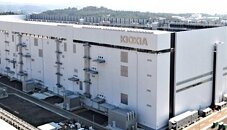Silicon Motion's SM2508 PCIe 5.0 NVMe SSD Controller is as Power Efficient as Promised
The first reviews of Silicon Motion's new PCIe 5.0 NVMe SSD controller, the SM2508 are starting to appear online, and the good news is that the controller is as power efficient as promised by the company. Tom's hardware has put up their review of a reference design M.2 SSD from Silicon Motion and in their testing, equipped with 1 TB of Kioxia's 162-layer BiCS6 TLC NAND. It easily bests the competition when it comes to power efficiency. In their file copy test, it draws nearly two watts less than its nearest competitor and as much as three watts less than the most power hungry drive. It's still using about one watt more than the best PCIe 4.0 drives, but it goes to show that the production nodes matters, as the SM2508 is produced on a 6 nm node, compared to 12 nm for Phison's E26.
We should point out that the peak power consumption did go over nine watts, but only one of the Phison E26 drives managed to stay below 10 watts here. The most power hungry PCIe 5.0 SSD controller in the test, the InnoGrit IG5666 peaks at nearly 14 watts for comparison. Idle power consumption of the SM2508 is also very good, still drawing more than the PCIe 4.0 drives it was tested against, but far less than any of the other PCIe 5.0 drives. What about performance you ask? The reference drive places itself ahead of all the Phison E26 drives when it comes to sequential file transfers, regardless if it's to or from the drive. Random read IOPS also places right at the top, but it's somewhat behind when it comes to random writes, without being a slow drive by any means. Overall we're looking at a very promising new SSD controller from Silicon Motion with the SM2508 and TPU has also received a sample that is currently undergoing testing, so expect a review here soon.
We should point out that the peak power consumption did go over nine watts, but only one of the Phison E26 drives managed to stay below 10 watts here. The most power hungry PCIe 5.0 SSD controller in the test, the InnoGrit IG5666 peaks at nearly 14 watts for comparison. Idle power consumption of the SM2508 is also very good, still drawing more than the PCIe 4.0 drives it was tested against, but far less than any of the other PCIe 5.0 drives. What about performance you ask? The reference drive places itself ahead of all the Phison E26 drives when it comes to sequential file transfers, regardless if it's to or from the drive. Random read IOPS also places right at the top, but it's somewhat behind when it comes to random writes, without being a slow drive by any means. Overall we're looking at a very promising new SSD controller from Silicon Motion with the SM2508 and TPU has also received a sample that is currently undergoing testing, so expect a review here soon.






























